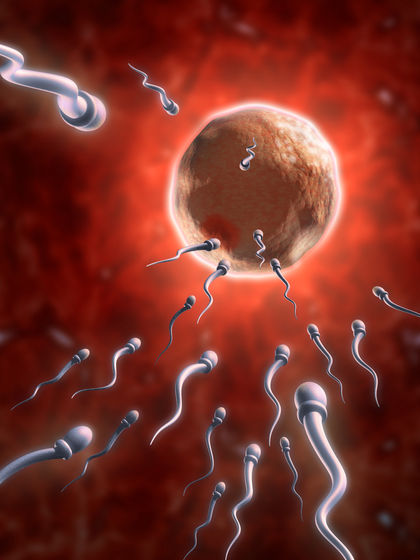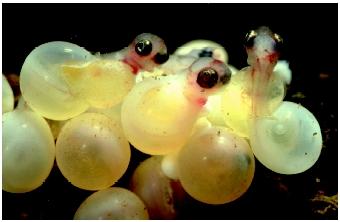Sexual Reproduction, Evolution of

The most basic way to reproduce is to make more copies of one's self, a process called asexual reproduction. In contrast, sexual reproduction involves the union of specialized sex cells (eggs and sperm) from two parents to produce genetically unique offspring.
Asexual Reproduction
A variety of ways exist by which organisms can reproduce asexually. Many protozoans, such as Euglena or Amoeba, undergo binary fission, whereby a single-celled organism divides evenly into two identical cells. Others, such as Trypanosoma (which causes African sleeping sickness), undergo multiple fission, involving repeated nuclear division before splitting into many daughter cells. Some organisms divide in a different way, with a single parent forming an outgrowth, or bud. Many yeasts, hydroids, and freshwater sponges reproduce by budding, typically in combination with sexual reproduction. A wide variety of organisms are capable of regenerating whole individuals from a fragment. Flatworms, sea anemones, green algae, and some

Parthenogenesis is another unique form of asexual reproduction in which female organisms are able to produce offspring from unfertilized eggs. Several species of nematodes , crustaceans, insects, and desert lizards are able to reproduce parthenogenetically. Many plants are capable of reproducing both asexually and sexually. Asexual reproduction occurs in a variety of ways, including production of rhizomes (horizontal underground stems), runners (aboveground stems that run along the ground), and suckers (vertical stems that arise from the base of stumps or existing stems).
Because asexually reproducing organisms produce identical copies of themselves, they pass on the maximum quantity of their own genetic material to each offspring: 100 percent. This kind of reproduction is typically very rapid.
Sexual Reproduction
In contrast, sexually reproducing individuals spend a considerable amount of time and energy locating mates, exchanging genetic material, and often caring for young. Sexual reproduction begins with production of sex cells via meiosis , a process that halves the genetic material of each parent in preparation for combination with another sex cell. Consequently, a sexually reproducing parent transfers only 50 percent of its genetic material to each offspring. This loss in genetic contribution to each offspring is known as the cost of meiosis. In addition to this cost, males produce enough sperm to fertilize the eggs of many females, yet many males in some species never even fertilize one egg, resulting in many wasted sperm. In light of all of these disadvantages, why did sexual reproduction evolve?
For some plants, spore-forming protozoans, and invertebrates, sexual reproduction may yield seeds or eggs that are resistant to harsh environments and are capable of being dispersed. However, scientists agree that the most important advantage of sexual reproduction is the variation produced by the continual recombination of sex cells to create unique individuals. In 1930, Ronald A. Fisher noted in The Genetical Theory of Natural Selection that this variation allowed evolution to occur at a faster rate. This idea led to two theories explaining how increased genetic variation might benefit individuals.
Importance of Genetic Variation
George Williams compared reproduction to a raffle in which one can either have many tickets with different numbers (sexual reproduction) or many tickets with the same number (asexual reproduction). If one doesn't know which number will be drawn in a raffle, it is better to have many different tickets. Similarly, organisms producing many unique individuals in an unpredictable environment have a greater chance that at least some their offspring will survive. Thus, Williams proposed that sexual reproduction evolved because of the benefits gained by organisms in fluctuating physical environments. This is often called the "bet-hedging" or "tangled bank" hypothesis.
Others argue that sexual reproduction evolved because of advantages gained in the face of changes in other organisms. Predators, prey, and parasites constantly improve their efficiency at capturing prey, evading predators, and extracting nutrients from hosts. Genetically variable offspring offer more opportunities for each to increase its efficiency. This is called the "Red Queen" hypothesis after the popular book, Alice in Wonderland, in which the queen tells Alice, "Now here, you see, it takes all the running you can do, to keep in the same place."
Scientists have collected data in support of each of these hypotheses. The bet-hedging or tangled bank hypothesis predicts that sexual reproduction should predominate in unpredictable environments, while asexual reproduction should be found more frequently in stable environments. In support of this prediction, scientists have found that when species alternate between sexual and asexual reproduction, they often reproduce asexually in the spring and summer but sexually in the fall and winter when the environment is harsher.
The Red Queen hypothesis, on the other hand, predicts that sexual reproduction should increase in frequency as rates of parasitism or predation increase. Curt Lively studied a species of snail that lives in lakes and streams in New Zealand. He found more parasites infecting the snails living in the lakes than the snails living in the streams. As predicted by the Red Queen hypothesis, the snails in the lakes were more likely to reproduce sexually than those living in the streams. Furthermore, the number of males in a population (an indicator of the frequency of sexual reproduction) increased as rates of parasitism increased. Scientists continue to seek support for each of these hypotheses, and it appears likely that each applies to at least some situations; both environmental and biotic fluctuations make sexual reproduction advantageous.
Michelle J. Solensky
Bibliography
Bell, Graham. The Masterpiece of Nature: The Evolution and Genetics of Sexuality. Berkeley, CA: University of California Press, 1982.
Fisher, Ronald A. The Genetical Theory of Natural Selection. Oxford: Clarendon Press, 1930.
Hamilton, William D., R. Axelrod, and R. Tanese. "Sexual Reproduction as an Adaptation to Resist Parasites." Proceedings of the National Academy of Science USA 87 (1990): 3566–3573.
Hurst, L. D., and William D. Hamilton. "Cytoplasmic Fusion and the Nature of Sexes." Proceedings of the Royal Society of London, Series B: Biological Sciences 247 (1992): 189–194.
Lively, Curt M. "Evidence from a New Zealand Snail for the Maintenance of Sex by Parasitism." Nature 328 (1987): 519–521.
Williams, George C. Sex and Evolution. Princeton, NJ: Princeton University Press, 1975.
Comment about this article, ask questions, or add new information about this topic: